Number Bonds
Number bonds show how numbers are split or combined. An essential strategy of Singapore maths, number bonds reflect the ‘part-part-whole’ relationship of numbers.

What is a number bond?
Number bonds let students split numbers in useful ways. They show how numbers join together, and how they break down into component parts. When used in Year 1, number bonds forge the number sense needed for early primary students to move to addition and subtraction. As students progress, number bonds become an essential mental problem-solving strategy.
Why are number bonds part of Singapore mathematics?
Number bonds are an essential component when teaching the Singapore method of maths for mastery . They foster number sense in students, and are an important concept within the Singapore primary curriculum. However so-called ‘Singapore Number Bonds’ are not a specifically Singaporean method — the term has been around since the 1920s.
How do number bonds work?
Number bonds are represented by circles connected by lines. The ‘whole’ is written in the first circle, while the ‘parts’ are in the adjoining circles.
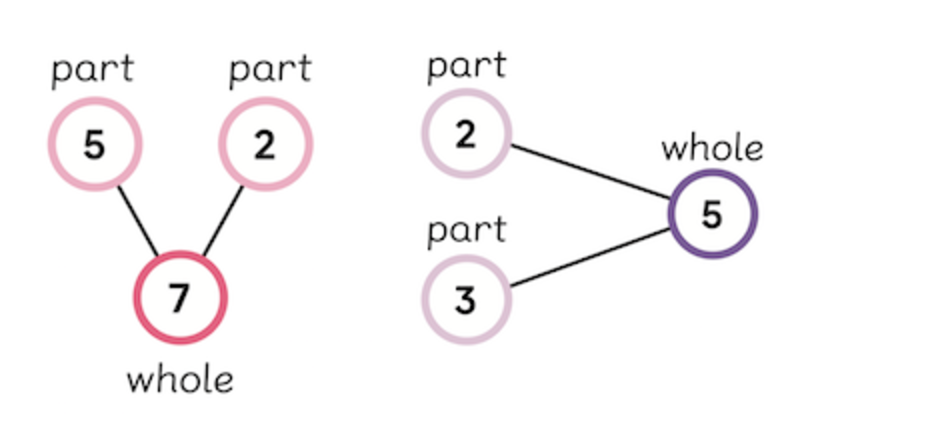
How to teach number bonds
Children are usually introduced to number bonds through the Concrete, Pictorial, Abstract (CPA) approach . Here’s just one way to introduce and teach number bonds.
Concrete step
Children start out by counting familiar real-world objects that they can interact with. They then use counters to represent the real-world objects. From here, they progress to grouping counters into two groups.
By putting five counters into two groups, children learn the different ways that five can be made. For example, 3 and 2 as illustrated below. With further exploration, children work out other ways to break numbers into two groups.
Pictorial step
Now that they understand the concept with hands-on objects and experience, children progress to writing number bonds in workbooks or on whiteboards. Early number bond explorations might simply reflect the two groups of counters that they created during the concrete step, along with other combinations.
Abstract step
With the concrete and pictorial steps done and dusted, children progress to representing abstract problems using mathematical notation (for example, 3 + 2 = 5).

Taking the concept a step further
Number bonds also develop problem-solving strategies such as ‘making ten’ with ten frames, multilink or unifix cubes.
By mastering number bonds early on, pupils build the foundations needed for subsequent learning and are better equipped to develop mental strategies and mathematical fluency. By building a strong number sense, pupils can decide what action to take when trying to solve problems in their head.
This example shows how a pupil would develop their number sense, or mathematical fluency, by using number bonds to perform a mental calculation.
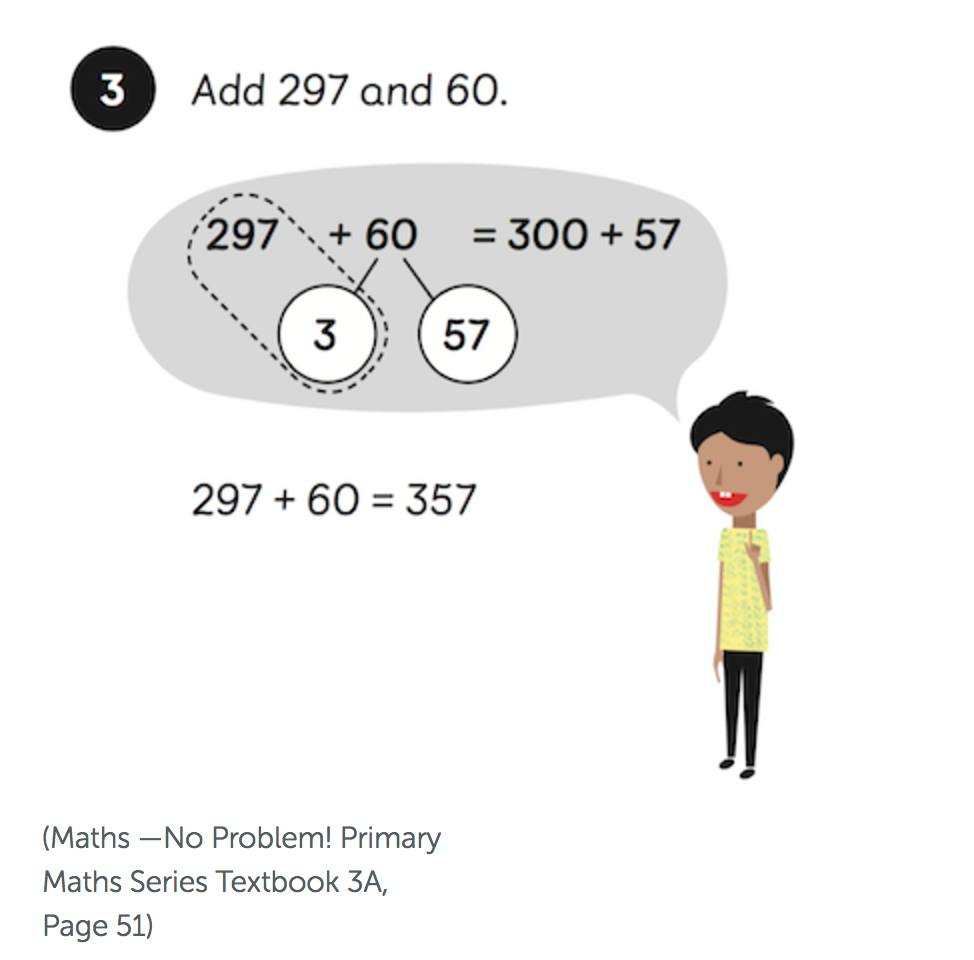
Find out how number bonds, proven mastery strategies, and world-class training can make maths better for everyone in your school.
For the community, by the community.
Maths — No Problem! Community Event Conference, 28 November at The Royal Society, London.

By clicking “Accept All” , you agree to the storing of cookies on your device to enhance site navigation, analyze site usage and assist in our marketing efforts.
Number Bonds to 10
These lessons, with videos, songs, examples, solutions, worksheets, games, and activities, help students learn number bonds in Singapore Math .
Related Pages More Singapore Math Lessons Number Bond Games
The following diagrams show to number bonds of 10. Scroll down the page for more examples and solutions.
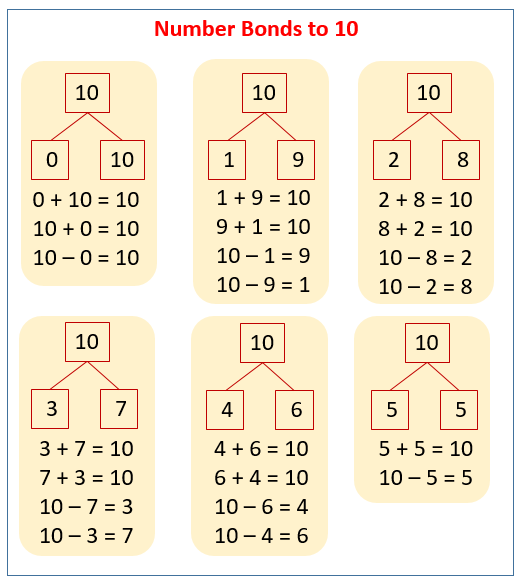
What is a Number Bond? Number bond is a concept used in Singapore Math and Common Core Math. It is a visual image that can be used to show the relationships between addition and subtraction.
A number bond consists of a minimum of three circles connected by lines. The “whole” is written in the first circle and its “parts” are written in the adjoining circles. The “parts” when added together will then equal the “whole”
The following number bond can be used to represent four number sentences. 3 + 2 = 5 2 + 3 = 5 5 − 3 = 2 5 − 2 = 3
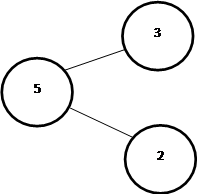
Number Bonds (Singapore Math) This video explains number bonds and how they can be used to make addition and subtraction number sentences.
Example: 5 + 3 = 8 3 + 5 = 8 8 - 5 = 3 8 - 3 = 5
Number Bonds Introduction and tutorial for Kindergarten and First Grade.
Number Bonds within 10 Part-part whole model.
Numbers To 10: Making number bonds with cubes The video shows how number bonds can be used to “split” numbers.
Songs for Number Bonds
Number Fun song that helps children understand Number Bonds to 10
Farmer Pete Number bond lyrics Farmer Pete he had 10 sheep. All were in the pen. 10 were safe and none had gone. 10 add 0 makes 10. “Oh dear!”, said Pete, “where is my sheep? There’s 9 here in the pen." 9 are safe and 1 has gone, 9 add 1 makes 10. “Oh dear!”, said Pete, “where are my sheep? There’s 8 here in the pen." 8 are safe and 2 have gone, 8 add 2 makes 10. “Oh dear!”, said Pete, “where are my sheep? There’s 7 here in the pen." 7 are safe and 3 have gone, 7 add 3 makes 10. “Oh dear!”, said Pete, “where are my sheep? There’s 6 here in the pen." 6 are safe and 4 have gone, 6 add 4 makes 10. “Oh dear!”, said Pete, “where are my sheep? There’s 5 here in the pen." 5 are safe and 5 have gone, 5 add 5 makes 10. “Oh dear!”, said Pete, “where are my sheep? There’s 4 here in the pen." 4 are safe and 6 have gone, 4 add 6 makes 10. “Oh dear!”, said Pete, “where are my sheep? There’s 3 here in the pen." 3 are safe and 7 have gone, 3 add 7 makes 10. “Oh dear!”, said Pete, “where are my sheep? There’s 2 here in the pen." 2 are safe and 8 have gone, 2 add 8 makes 10. “Oh dear!”, said Pete, “where are my sheep? There’s 1 here in the pen." 1 is safe and 9 have gone, 1 add 9 makes 10. “Oh dear!”, said Pete, “where are my sheep? There’s none here in the pen." None are safe and 10 have gone, 0 add 10 makes 10.
Farmer Pete Number bond song with lyrics and animation
What Makes Ten? - song A song to help you learn what makes ten. 0 + 10 = 10 1 + 9 = 10 2 + 8 = 10 3 + 7 = 10 4 + 6 = 10 5 + 5 = 10 6 + 4 = 10 7 + 3 = 10 8 + 2 = 10 9 + 1 = 10 10 + 0 = 10
Number bonds are pairs of friends - number bonds to 10 song Number bonds are pairs of friends And all together they make ten They will stick together until the end They make ten! They make ten! 9 and 1 … Number bonds are fun 8 and 2 … Maths is good for you 7 and 3 … Sing along with me 6 and 4 … Let’s sing some more 5 and 5 … Makes me feel alive
4 and 6 … Numbers in the mix 3 and 7 … Number bond heaven 2 and 8 … Number bonds are great 1 and 9 … Counting all the time 5 and 5 … Makes me feel alive
Number Bonds in the Common Core Standards for mathematics education This video is suitable for parents and teachers who want to find out more about the advantages of using number bonds. Number bond is a representation that supports children in seeing composing-decomposing actions (a prerequisite skill for developing arithmetic strategies).
Advantages of Number Bonds
- Support learner’s attempts to ‘decontextualize’ the mathematical relationships embedded in words.
- Provides a graphic that helps learners see how quantities are related. (helps them see parts and whole)
- Serves as a ‘bridge’ between concrete representations and the more formal symbolic language of mathematics (equations)
- Can ‘grow’ with learner’s mathematical development (serves a future role as well)
Number bonds for additive relationships - one graphic effectively demonstrates the relationships between 3 whole numbers. They can be a useful tool in exploring the commutative property of addition. Number bonds can be used to model number relationships and are useful representations for facilitating connections.
- Children learn to represent a mathematical situation with concrete materials.
- They learn to identify parts and whole through dialog with teachers and peers as the number bond is being constructed.
- They start to make number bonds on their own.
- They start to write equations for easiest problem types (result unknown / total unknown problems) after extensive teacher modeling.

We welcome your feedback, comments and questions about this site or page. Please submit your feedback or enquiries via our Feedback page.

Or search by topic
Number and algebra
- The Number System and Place Value
- Calculations and Numerical Methods
- Fractions, Decimals, Percentages, Ratio and Proportion
- Properties of Numbers
- Patterns, Sequences and Structure
- Algebraic expressions, equations and formulae
- Coordinates, Functions and Graphs
Geometry and measure
- Angles, Polygons, and Geometrical Proof
- 3D Geometry, Shape and Space
- Measuring and calculating with units
- Transformations and constructions
- Pythagoras and Trigonometry
- Vectors and Matrices
Probability and statistics
- Handling, Processing and Representing Data
- Probability
Working mathematically
- Thinking mathematically
- Mathematical mindsets
- Cross-curricular contexts
- Physical and digital manipulatives
For younger learners
- Early Years Foundation Stage
Advanced mathematics
- Decision Mathematics and Combinatorics
- Advanced Probability and Statistics
One Big Triangle
- Getting Started
- Student Solutions
- Teachers' Resources
One Big Triangle printable sheet
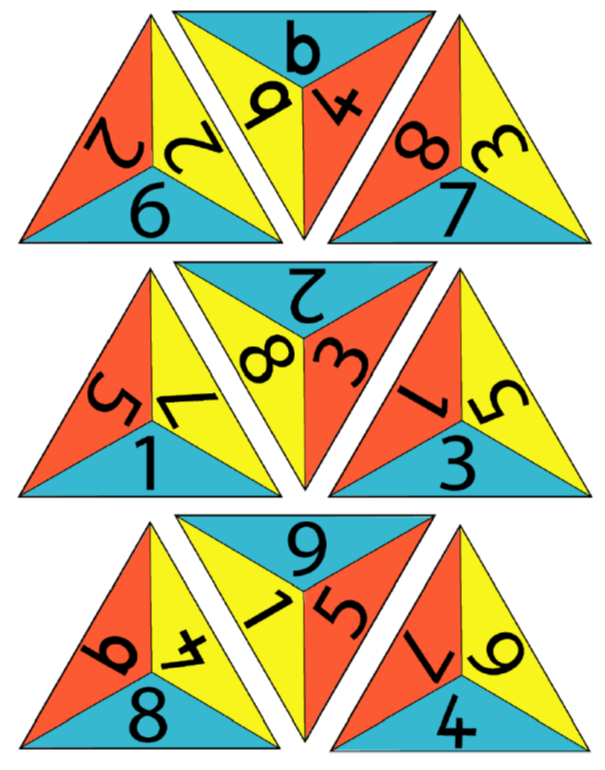
Once you've finished making the big triangle, think about these questions: How did you get started? What did you do next? You can print out the sheet at the top of this page and cut the triangles out, then try arranging them. If you prefer, you can also use a printable version of the triangles with numbers represented on tens frames .
Alternatively, you might like to use this interactivity, which allows you to drag each triangle onto the large triangle.
Why do this problem?
This problem is useful for consolidating number bonds to 10 and the corresponding subtraction facts. The novel context is likely to appeal to learners and encourage them to persevere. Children who are fluent with number bonds to 10 will still be challenged as the approach is not obvious, but logical reasoning will help them become more efficient in their search for a solution. The task will also draw on learners' geometrical reasoning too as they visualise triangles in different positions and orientations in order to solve the problem.
Possible approach
Key questions.
Can you find a different card with that number on it? What might be helpful to try next?
Possible extension
Children could be asked whether they can find more than one solution. How will they know whether another solution is the same or different to any they have already got? How will they know that they have found all the solutions? Learners could also use the cards to make a shape (not necessarily a triangle) where the touching numbers add to 9 (or 8 or 11). Alternatively, they could add their own choice of numbers to blank triangular pieces to create their own activity.
Possible support
Children could use the cards to make a different shape (not necessarily a triangle) where the touching numbers add to 10, and/or the tens frame cards could be used to provide more support. Some children may find it difficult to cope with matching more than one pair of numbers at a time, in which case a domino activity would be more accessible. A set of nine-spot dominoes would be useful for this and you can find one on our printable resources page . The task could be to join the dominoes together so that the 'match' adds to 10 or any other number of the children's choice. This will then give them plenty of practice in identifying number bonds.

Are you on the lookout for a dynamic resource to reinforce number bonds to 10 in your maths lessons? Dive into the "Make 10" worksheet, a free resource tailored for foundation, grade 1, and grade 2 students. Designed to foster understanding and fluency in number bonds, this engaging worksheet offers an interactive approach to mastering essential maths skills.
Exploring "Make 10"
The "Make 10" worksheet presents students with a series of 10 frames, each containing a varying number of counters. Students are tasked with completing each 10 frame by drawing additional counters to make a full set of 10. As they engage with the worksheet, students reinforce their understanding of number bonds to 10 in a hands-on and interactive manner.
How to Use the Worksheet:
Observation: Begin by examining each 10 frame on the worksheet. Take note of the number of counters already present in each frame.
Completion: Using a pencil or crayon, draw additional counters in each 10 frame to make a total of 10. For example, if a frame contains 3 counters, draw 7 more to complete the set.
Number Sentence: Beneath each 10 frame, students will find a space to write the corresponding number sentence. Record the addition equation that represents the completion of each 10 frame. For instance, if 3 counters are already present, the number sentence would be "3 + 7 = 10".
Reflection: Encourage students to reflect on the concept of number bonds as they complete each 10 frame. Discuss strategies for identifying combinations of numbers that add up to 10.
Benefits of "Make 10"
Hands-On Learning: Through drawing and completing 10 frames, students actively engage with the concept of number bonds, fostering a deeper understanding of addition and number relationships.
Visual Representation: The visual nature of the worksheet allows students to visualize and conceptualize number bonds to 10, enhancing their mathematical reasoning and problem-solving skills.
Personalized Learning: Students have the opportunity to work at their own pace, drawing on their existing knowledge and skills to complete each 10 frame and corresponding number sentence.
Download Now and Enhance Learning!
Ready to empower your students with a dynamic resource for mastering number bonds to 10? Click the button below to download the "Make 10" worksheet and ignite a journey of mathematical exploration and discovery!

Free Related Resources

A great visual representation on the number bonds to 10.

Spin a number and find the matching number that would add to 10.

Use playing cards to work out how many more would make 10.

Make the number in the box by drawing dots to add up to the given number.

Shake 5 counters, colour the circles to match your results.

Practise number facts by filling in the addition and subtraction equations.

Make the butterflies wings add up to 10.

Colour the desserts that have friends of 10 facts.

A great print and play game to practise friends of 10.

Colour the lollies to show different ways to add to the given number.

Make a booklet and use concrete materials to solve the friends of 5 activities on each page.

Find out why teachers and school leaders love PlanBee
- 📚 Cross-Curricular Topics
- ✂️ Design & Technology
- ♻️ Education for Social Responsibility
- 🌍 Geography
- ⛪️ Religious Education
- 🎉 Special Days
- 🦸♀️ Special People
- Vision and Principles
- Our Curriculum Offer
- Curriculum Packs
- Become a School Subscriber
- FREE Schemes of Work
- Learn at Home
- Objective Checker
- How does it work?
Number Bonds
What are number bonds.
Number bonds are pairs of numbers that can be added together to make another number e.g. 5 + 5 = 10. They are an important part of maths because they support children in recognising number patterns and developing mental recall. Number bonds can be used to aid mental arithmetic speed and fluency.
What are number bonds to 5?
Number bonds to 5 are pairs of numbers that can be added together to make 5. Learning number bonds to 5 is often children’s first experience of number bonds. They can be done easily using fingers and involve groups of numbers that are easy to visualise.
Number bonds to 5 include:
What are number bonds to 10?
Number bonds to 10 are pairs of numbers that can be added together to make 10. Learning number bonds to 10 supports children solving a range of number problems and helps them become familiar with the number system.
Developing a quick recall of number bonds to 10 allows children to begin to understand the concept of partitioning and bridging 10. For example to a solve problem like, 8 + 5 children can partition the 5 into 2 and 3 and then use their knowledge of number bonds to 10. The number sentence 8 + 5 could then be solved like this:
= 8 + 2 + 3
Number bonds to 10 include:
0 + 10 = 10
10 + 0 = 10
What are number bonds to 20?
Number bonds to 20 are pairs of numbers that can be added together to make 20. Learning number bonds to 20 supports children's fluency with addition when solving a range of number problems.
Number bonds to 20 include:
0 + 20 = 20
1 + 19 = 20
2 + 18 = 20
3 + 17 = 20
4 + 16 = 20
5 + 15 = 20
6 + 14 = 20
7 + 13 = 20
8 + 12 = 20
9 + 11 = 20
10 + 10 = 20
11 + 9 = 20
12 + 8 = 20
13 + 7 = 20
14 + 6 = 20
15 + 5 = 20
16 + 4 = 20
17 + 3 = 20
18 + 2 = 20
19 + 1 = 20
20 + 0 = 20
What are number bonds to 100?
Number bonds to 100 are pairs of numbers that can be added together to make 100. Learning number bonds to 100 supports childrens fluency with addition when solving a range of number problems.
In order to be able to work out number bonds to 100 children need to have a good understanding of place value.
Number bonds to 100 include:
50 + 50 = 100
30 + 70 = 100
25 + 75 = 100
99 + 1 = 100
0 + 100 = 100
COLLECTION KS1 Maths Packs
LESSON PACK Let's Learn Number Bonds | Year 1 Maths
LESSON PACK Let's Use Number Facts | Year 1 Maths
LESSON PACK Let's Use Number Bonds | Year 2 Maths
FREE Number Bond Socks 0-10
FREE Number Bond Socks 0-20
FREE Number Bonds Rainbows
FREE Number Bonds to 5 Worksheets
FREE Number Bonds to 10 Worksheets
FREE Number Bonds to 20 Worksheets
FREE Number Bonds to 100 Worksheets
Added to your cart:
What's Your Email?

Let customers speak for us
I really like the display cards which are clear and concise with enough information to spark children's interest.
Unfortunately, I took out the 7 day free access when I was very busy so only had a Quick Look! It has run out now. Looked good.
Hi Davina, thank you for taking the time to leave us a review! We hope to see you at the hive again soon :-)
Absolutely love this, thank you
You're welcome, La-Rochelle!
Great looking certificates. I love the description underneath, so useful for a busy teacher who wants to give her pupils a boost and let them know that this is what matters even more than academic achievement.
Thanks, Tessa - it's great to know that you are finding these certificates helpful :-)
Lots of useful resources for teaching year 1 about Florence Nightingale. I particularly like the knowledge organiser!
Thank you for taking the time to leave us a review, Charl - we're so pleased to hear that you have found our resources useful!
Resources you can trust
Number bonds to 10 – money
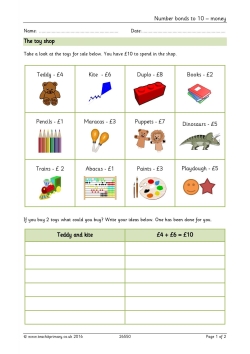
This number bonds to 10 activity is a dynamic and engaging tool designed to help children master their bonds to 10, within a real-life context of a toy shop. An engaging KS1 problem solving activity, with the skills of addition and money all in one resource!
How does this resource engage children
The resource engages children's learning by making mathematical concepts tangible and relatable. By integrating everyday scenarios like shopping at a toy store, it helps children see the practical applications of maths, sparking their interest and enhancing their understanding.
How to teach children number bonds to 10 with this resource
You can teach children number bonds to 10 by using this worksheet. Start by introducing the concept of number bonds, which are pairs of numbers that add up to 10. Use the toy shop scenario to make it more engaging. Children can choose different toys with different prices, and their goal is to find pairs of toys that total 10 pounds. This way, they practice addition while learning about money and getting familiar with the concept of spending.
All reviews
Resources you might like.
Number bonds to 10: Reasoning and Problem Solving


- Home Learning
- Free Resources
- New Resources
- Free resources
- New resources
- Filter resources
- Childrens mental health
- Easter resources
Internet Explorer is out of date!
For greater security and performance, please consider updating to one of the following free browsers
Number Bonds to 10 Lesson
This Year 1 Number Bonds to 10 lesson covers the prior learning of creating bonds to 10 using practical equipment, before moving onto the main skill of working writing and recalling number bonds to 10.
The lesson starts with a prior learning worksheet to check pupils’ understanding. The interactive lesson slides recap the prior learning before moving on to the main skill. Children can then practise further by completing the activities and can extend their learning by completing an engaging extension task.
National Curriculum Objectives
Mathematics Year 1: (1C1) Represent and use number bonds and related subtraction facts within 10
Mathematics Year 1: (1C2b) Read, write and interpret mathematical statements involving addition (+), subtraction (–) and equals (=) signs
Get the most from lessons!

Resources for teachers

Interactive activities for children
2 Teaching Support
Subscription
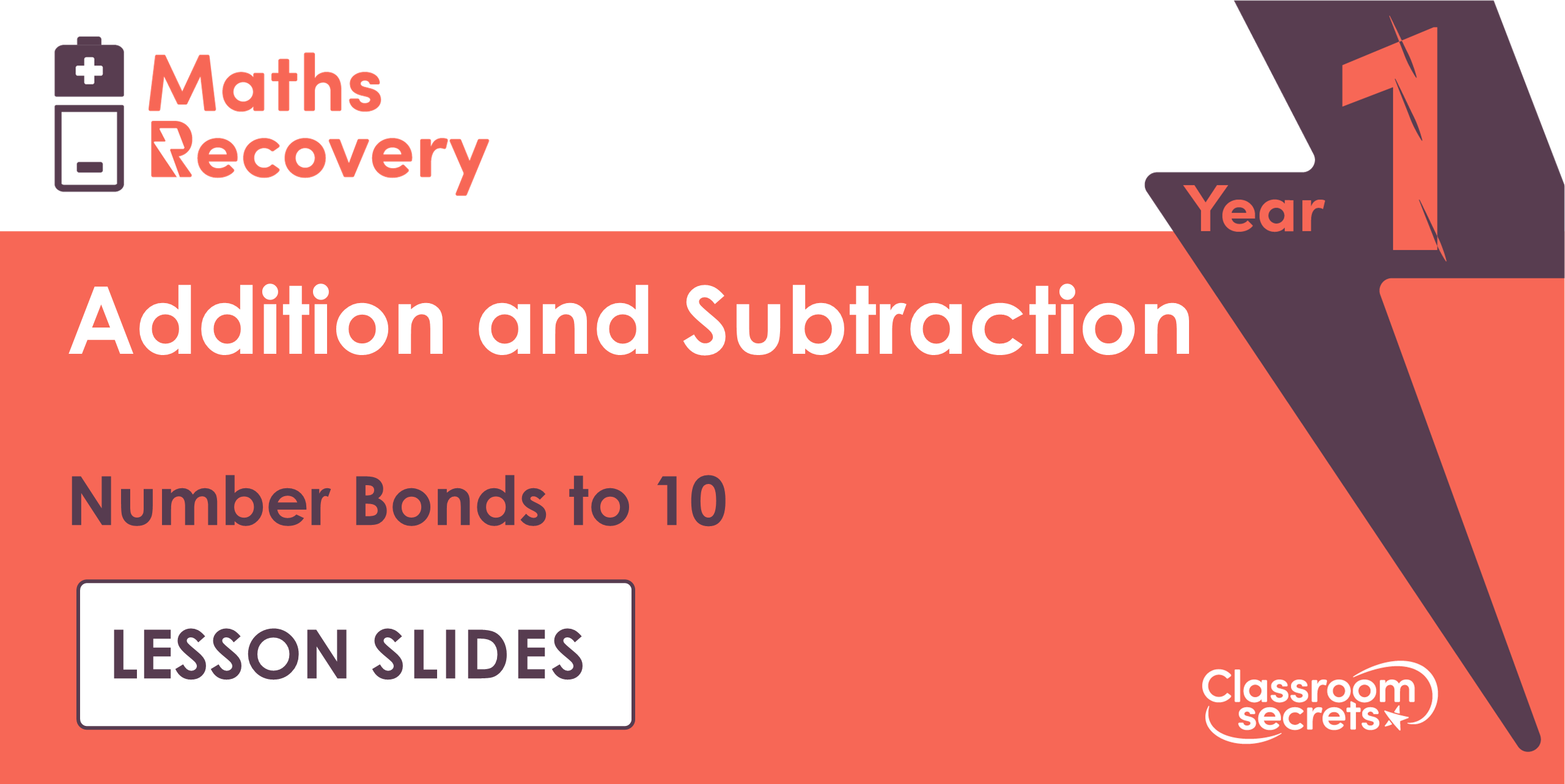
Lesson Slides
These lesson slide guide pupils through the prior learning of creating bonds to 10 using practical equipment, before moving onto the main skill of number bonds to 10. There are a number of questions to check pupils' understanding throughout.

Modelling PowerPoint
This powerpoint can be used to model the questions that the children will complete on the Varied Fluency and Reasoning & Problem Solving worksheets as part of this lesson.
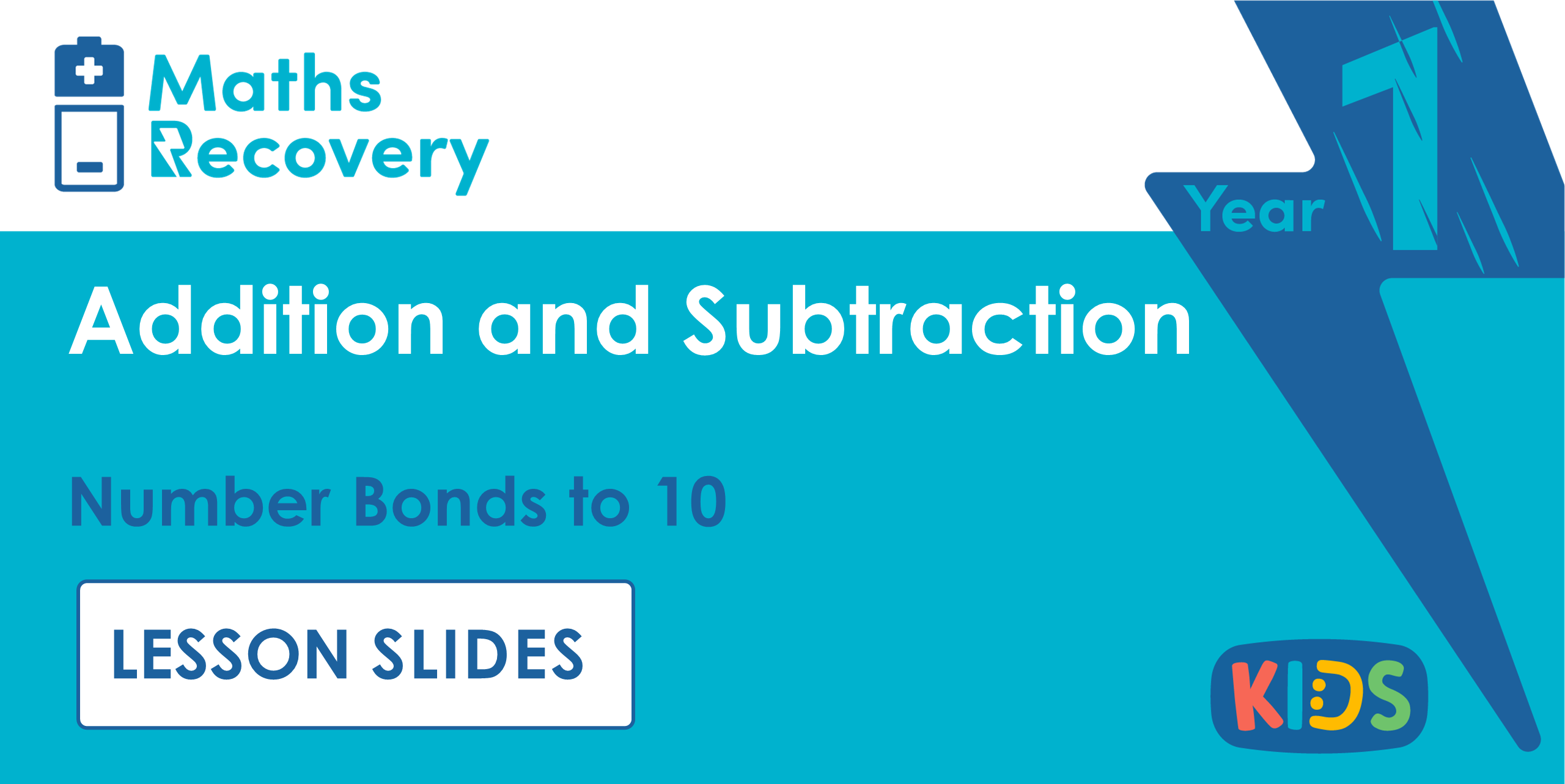
These are the same as the lesson slides on Classroom Secrets. You can assign this as an activity for pupils to access individually in school or remotely from home.
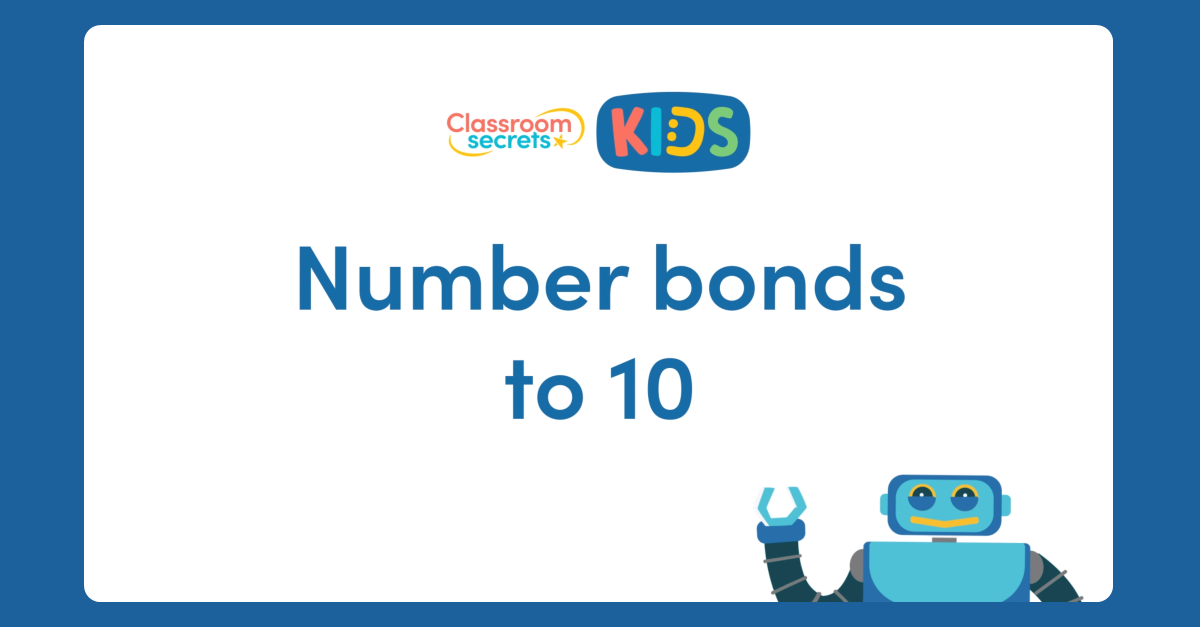
Video Tutorial
Katie shows pupils how to use practical materials to create a mini abacus to work out their number bonds in this Number Bonds to 10 Video Tutorial.
1 Prior Learning
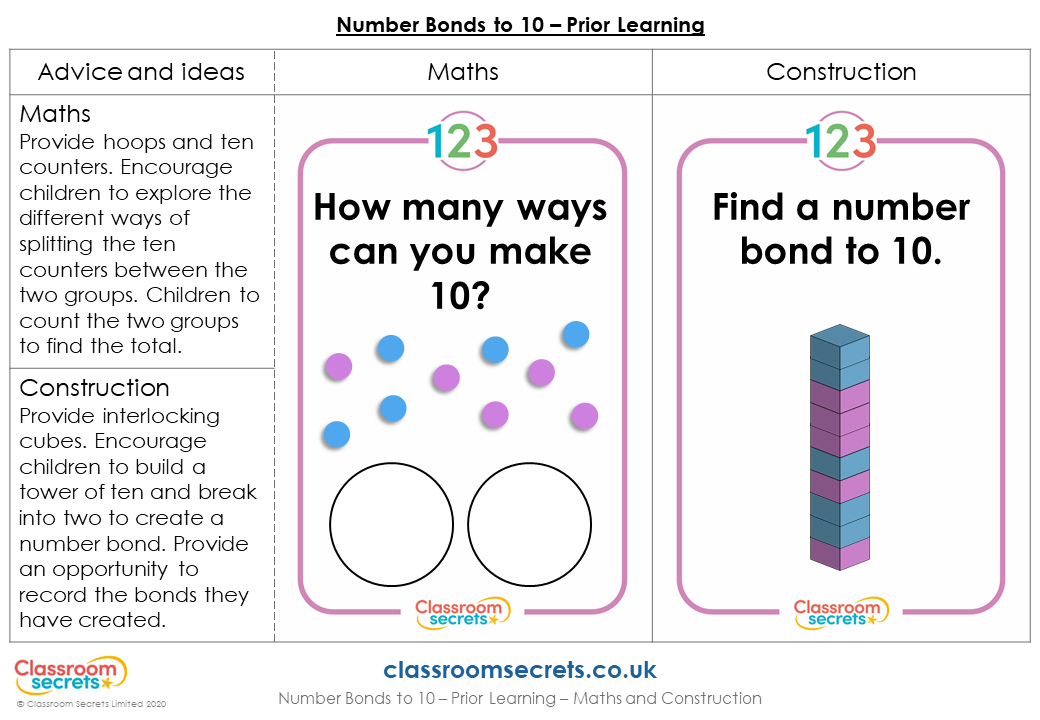
This worksheet recaps prior learning of creating bonds to 10 using practical equipment, before moving onto the main skill of working writing and recalling number bonds to 10.
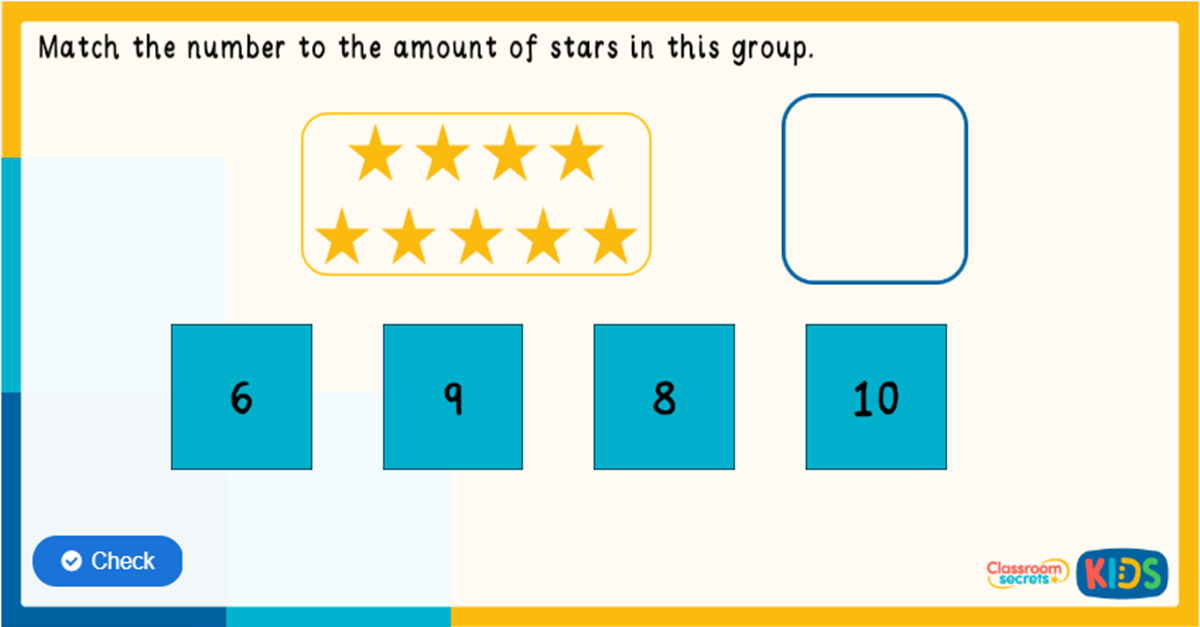
Interactive Activity
This Reception Count and Match Game will help children to develop one-one correspondence skills.
2 Practical Activities
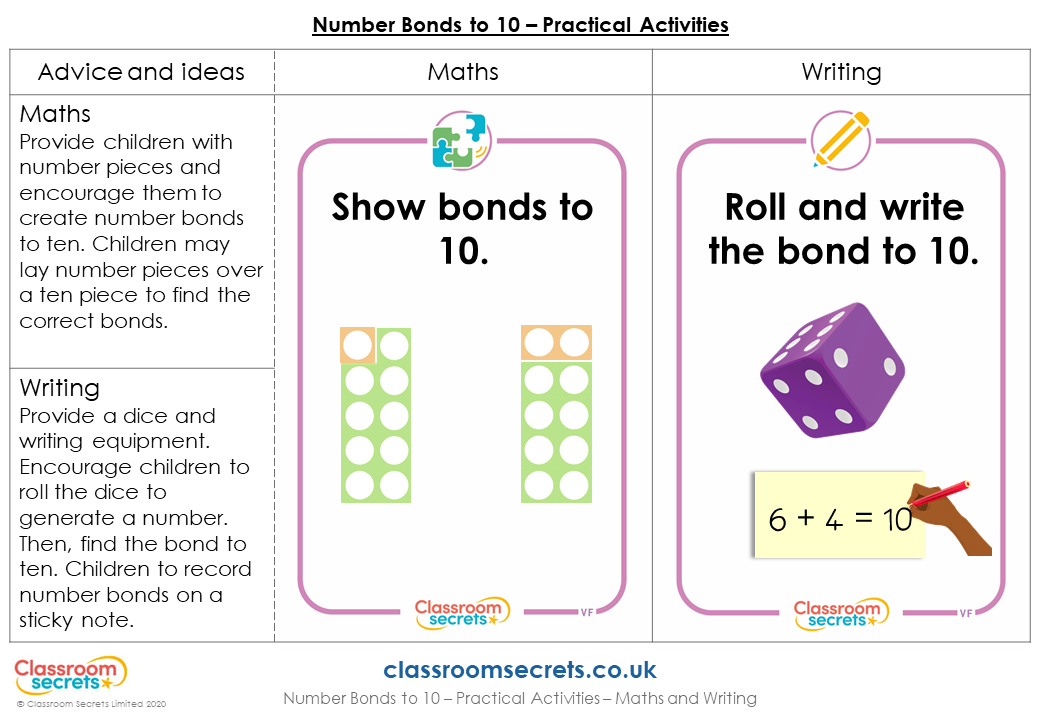
Practical Activities
These practical activities include tasks covering a range of provision areas for pupils to practise the main skill of number bonds to 10.
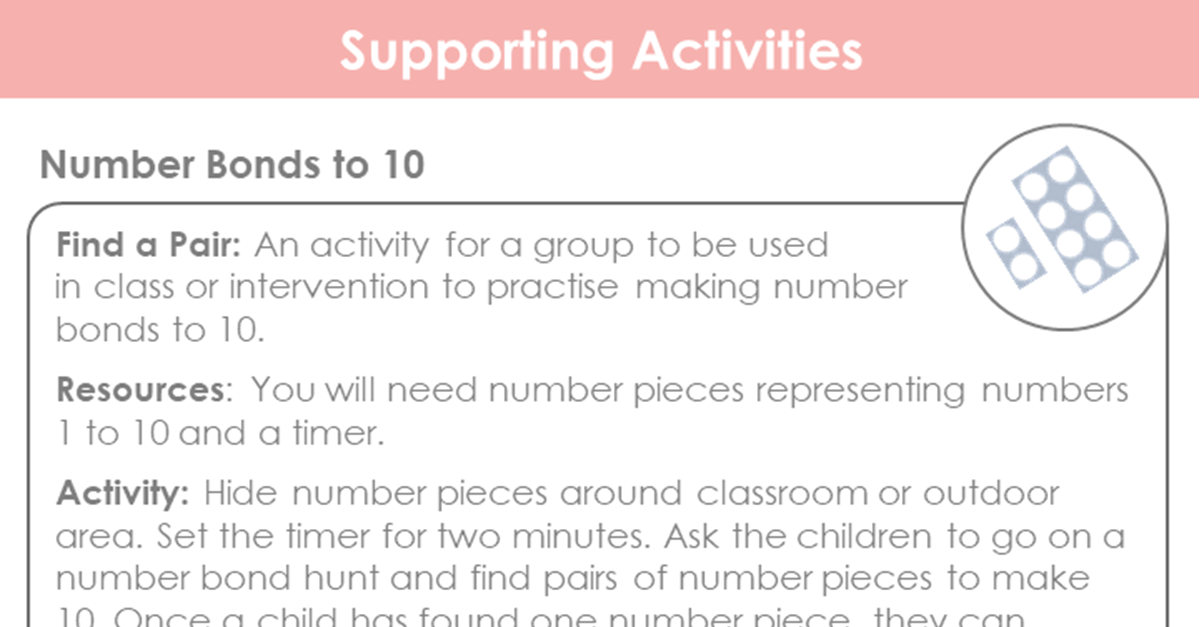
Supporting Activity
This number bonds to 10 supporting activities sheet contains suggestions for additional tasks you might wish to use to support pupils' understanding of the concepts taught in the lesson.
2 Varied Fluency

This differentiated worksheet includes varied fluency questions for pupils to practise the main skill of this lesson.
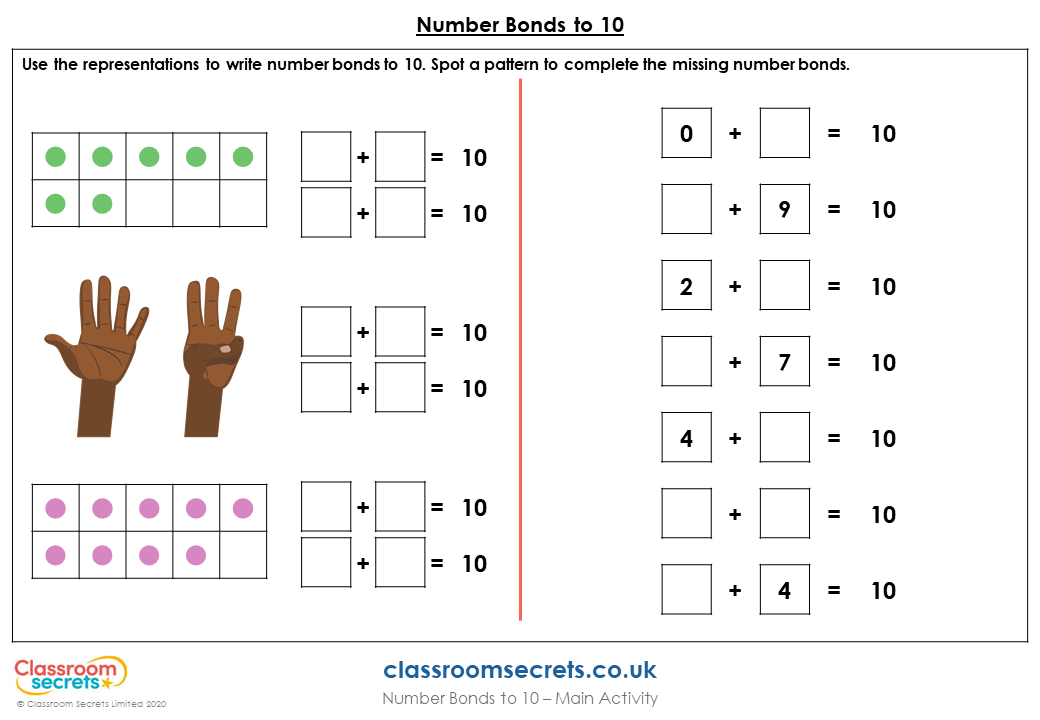
Mixed Practice
This worksheet includes varied fluency questions for pupils to practise the main skill of number bonds to 10.
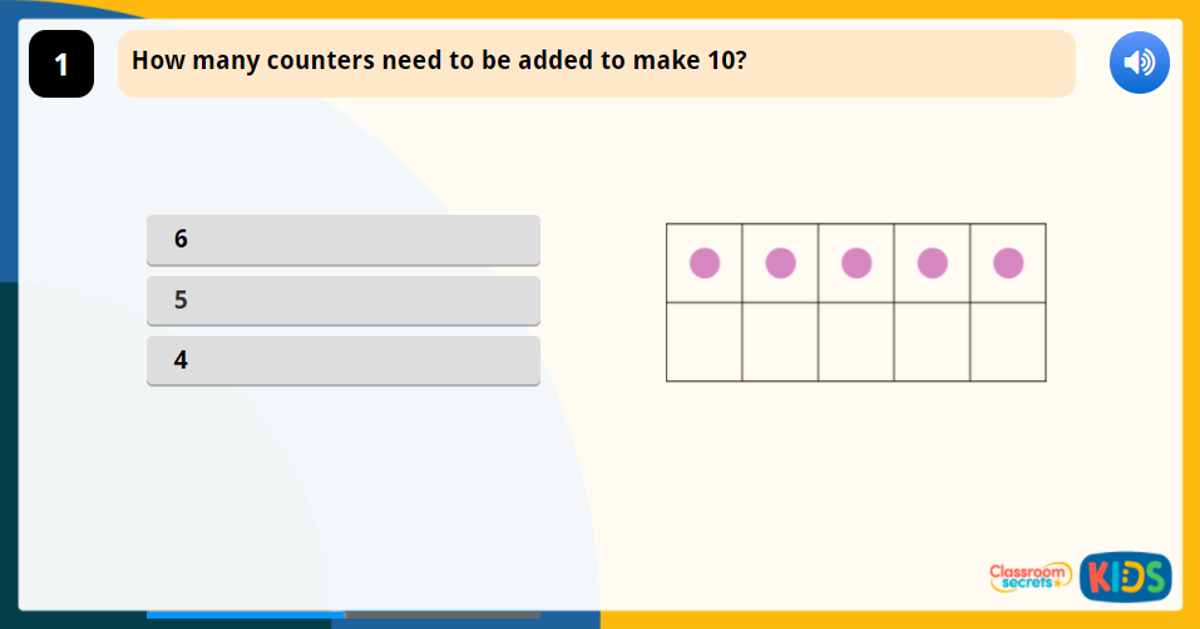
This Year 1 Number Bonds to 10 Game is designed to check pupils' understanding of finding all number bonds to 10.
2 Reasoning & Problem Solving
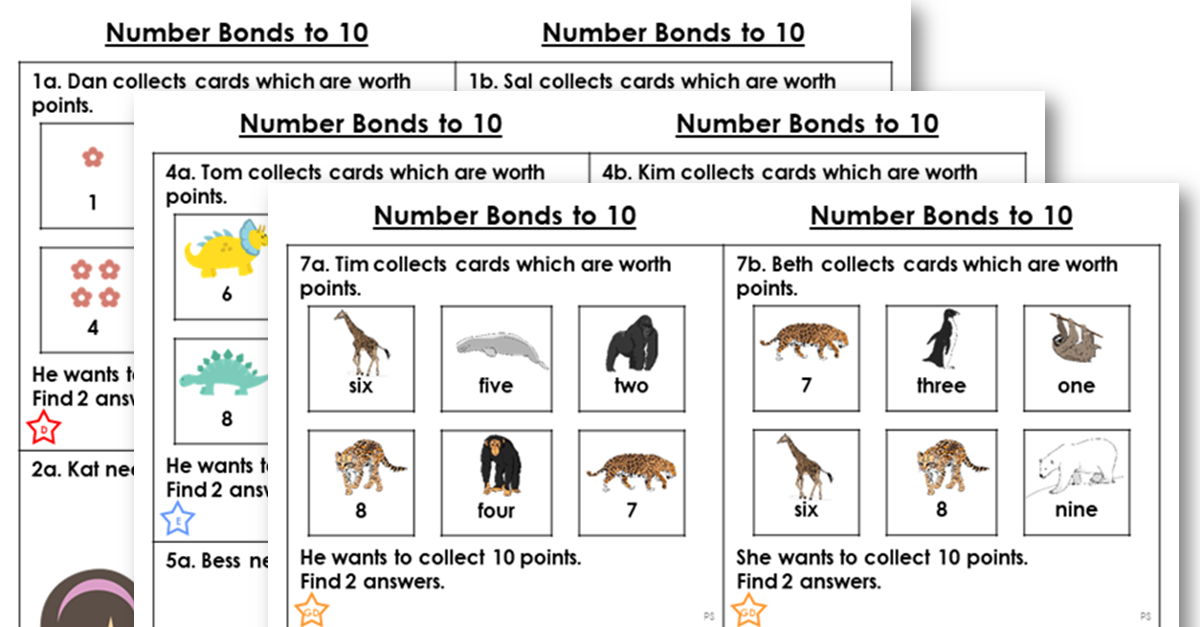
This differentiated worksheet includes reasoning and problem solving questions to support the teaching of this step.
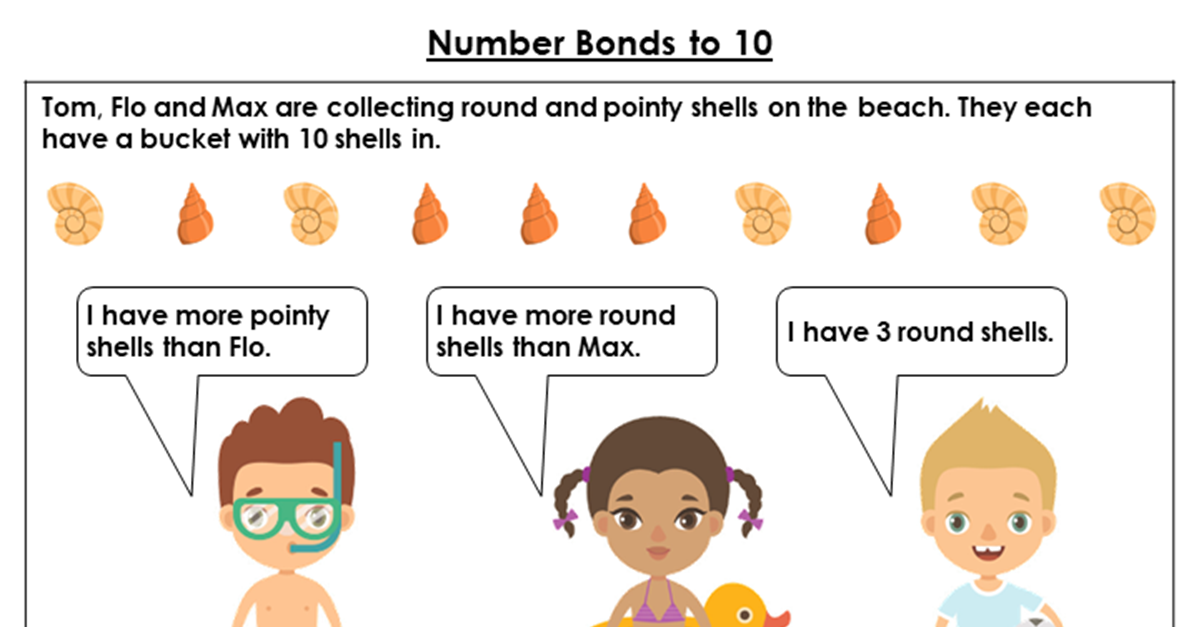
This number bonds to 10 extension task includes a challenge activity which can be used to further pupils' understanding of the concepts taught in the number bonds to 10 lesson.

Discussion Problem
This worksheet includes two discussion problems which can be used in pairs or small groups to further pupils' understanding of the concepts taught in this lesson.
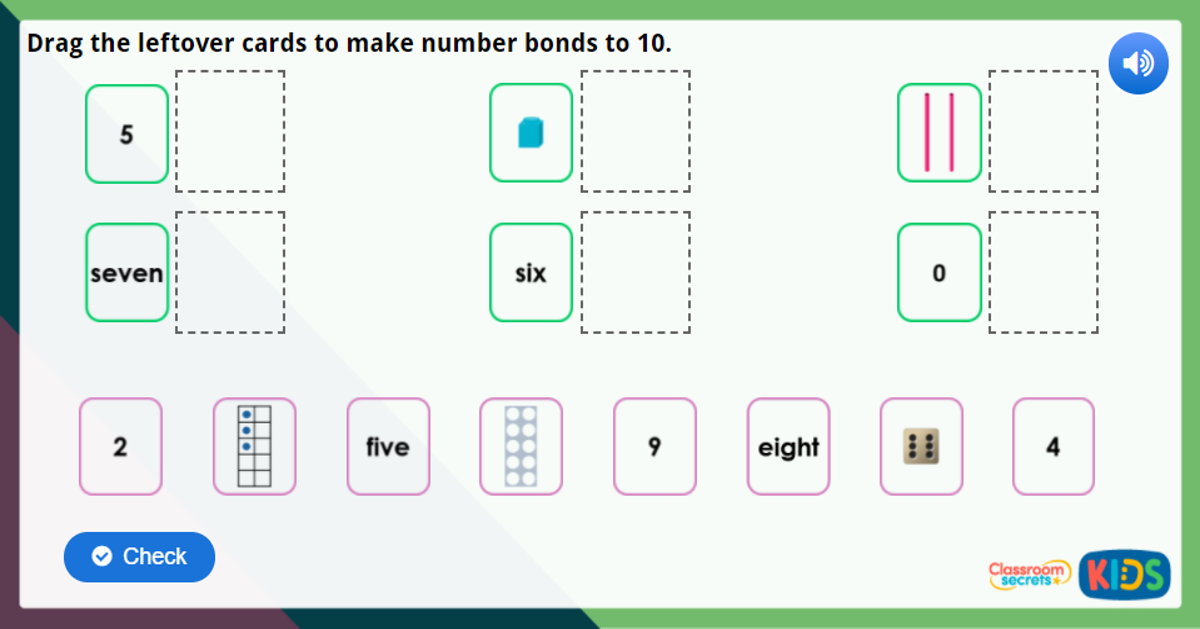
Interactive Challenge Activity
This Year 1 Number Bonds to 10 Maths Challenge is designed to check pupils' understanding of finding number bonds to 10.
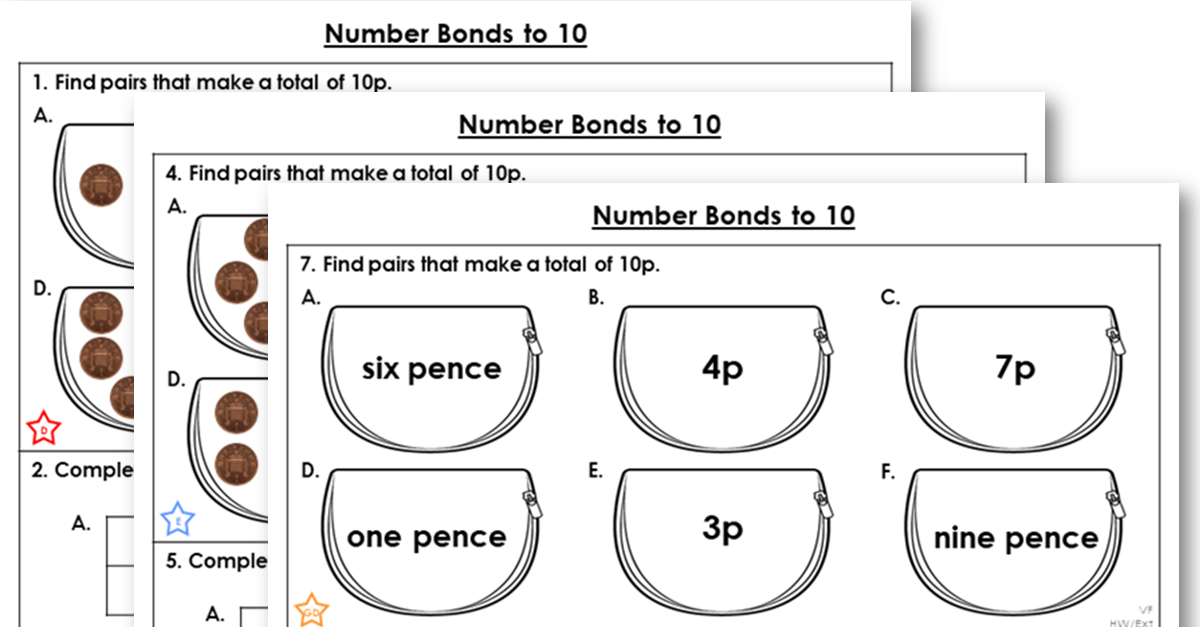
This differentiated worksheet includes varied fluency and reasoning and problem solving questions to support the teaching of this step.
2 Additional Activities

Consolidation Pack
This resource is aimed at Year 1 Expected and has been designed to give children the opportunity to consolidate the skills they have learned in Autumn Block 2 – Addition and Subtraction.
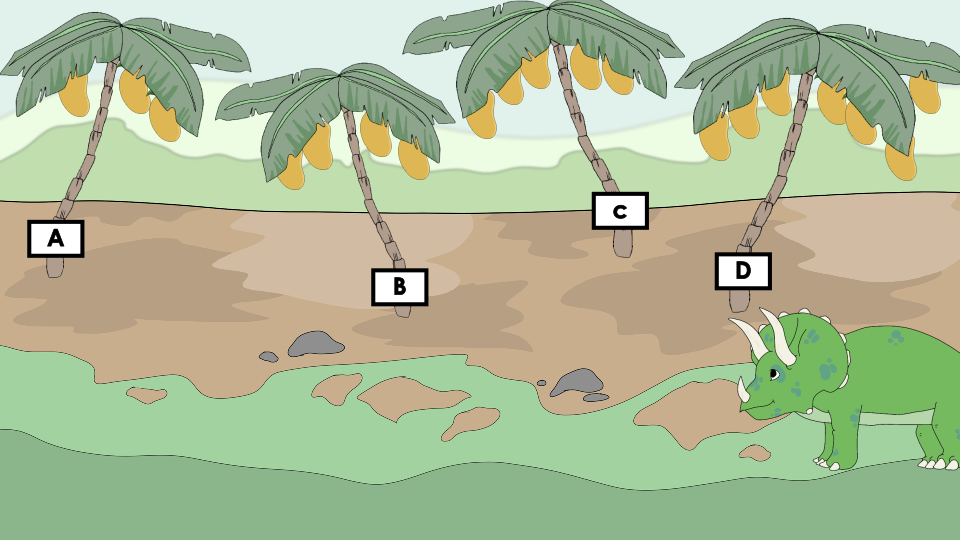
Learning Video Clip
Dot the Dinosaur is on her way to find some food but the berries she usually eats have all gone! She needs to find some more food and ventures further into the forest. Help Dot in her quest using your knowledge of number bonds to 10!

Home Learning Pack
This Autumn week 6 Maths pack contains varied fluency, reasoning and problem solving worksheets
D Download Packs
Stay in touch.
01422 419608
[email protected]
Interested in getting weekly updates from us? Then sign up to our newsletter here!
| Thank you for Signing Up |

Information

- Cookie Policy
- Privacy Policy
- Terms and Conditions
Copyright: Classroom Secrets 2024
Company number: 8401067
VAT number: 248 8245 74
- Terms & Conditions
Designed by Classroom Secrets
Google's AI models achieve new heights in Olympic problem solving

Monty Rakusen/DigitalVision via Getty Images
Google's ( NASDAQ: GOOG )( NASDAQ: GOOGL ) artificial intelligence models have reached new heights after achieving silver-medal standards through solving International Mathematical Olympiad, or IMO, problems.
Google's AlphaProof and AlphaGeometry 2 models, which are based on Gemini, solved four out of six problems from this year's IMO, which is equivalent to a silver medal performance, the company revealed today in a blog post.
The IMO, held annually since 1959, challenges the world's most elite young mathematicians with the most difficult problems in algebra, combinatorics, geometry and number theory. These problems have also come to gauge the abilities of AI systems as well.
Human contestants in the IMO challenge have to answer six complex problems in two four-and-a-half hour sessions.
Google's AI systems solved four of the six problems, one within minutes and the others requiring three days.
"AlphaProof solved two algebra problems and one number theory problem by determining the answer and proving it was correct," the company said. "This included the hardest problem in the competition, solved by only five contestants at this year’s IMO. AlphaGeometry 2 proved the geometry problem, while the two combinatorics problems remained unsolved."
Former gold medal winners of the event were impressed.
"The fact that the program can come up with a non-obvious construction like this is very impressive, and well beyond what I thought was state of the art," said Sir Timothy Gowers, former IMO gold medalist and Fields Medal winner.
AI models continue to advance at a rapid rate. Microsoft-backed ( MSFT ) Mistral AI revealed its newest large language model, Mistral Large 2, yesterday.
One day prior, Meta Platforms ( META ) unveiled its largest language model yet, Llama 3.1 405B.
"Artificial general intelligence with advanced mathematical reasoning has the potential to unlock new frontiers in science and technology," Google said.
More on Alphabet, Alphabet, etc.
- Google Q2: Price Correction Offers Entry Point
- Alphabet Q2 2024 Earnings Update
- Google: Q2 Earnings, Buying The Near-Term Weakness
- Tech sell-off likely to be 'short-lived' as AI, cloud helps power earnings: Wedbush
- Microsoft introduces gen-AI to Bing search, similar to Google's AI Overviews
Recommended For You
Related stocks.
| Symbol | Last Price | % Chg |
|---|---|---|
| GOOG | - | - |
| GOOGL | - | - |
Trending Analysis
Trending news.

Home / Number frame number bonds (within 20) | Mastery Cards
Number frame number bonds (within 20) | Mastery Cards
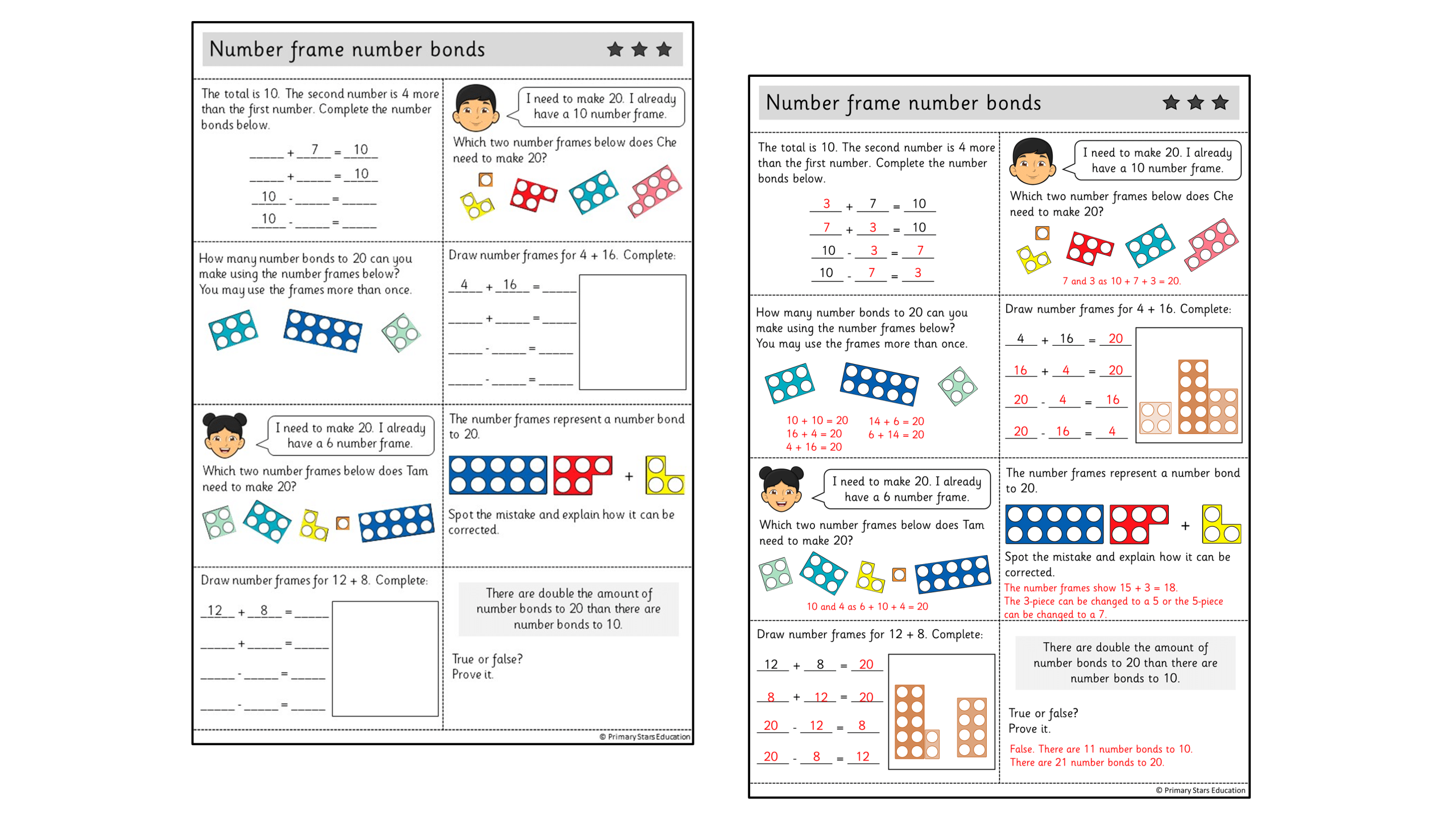
Problem solving and reasoning cards allowing children to solve complex problems in various contexts for number frame number bonds.
- Curriculum Links
Tried this resource? Add a photo Add a photo
What worked / did not work well? Have you spotted an error? Any other comments? Leave Feedback Leave Feedback
Related Products
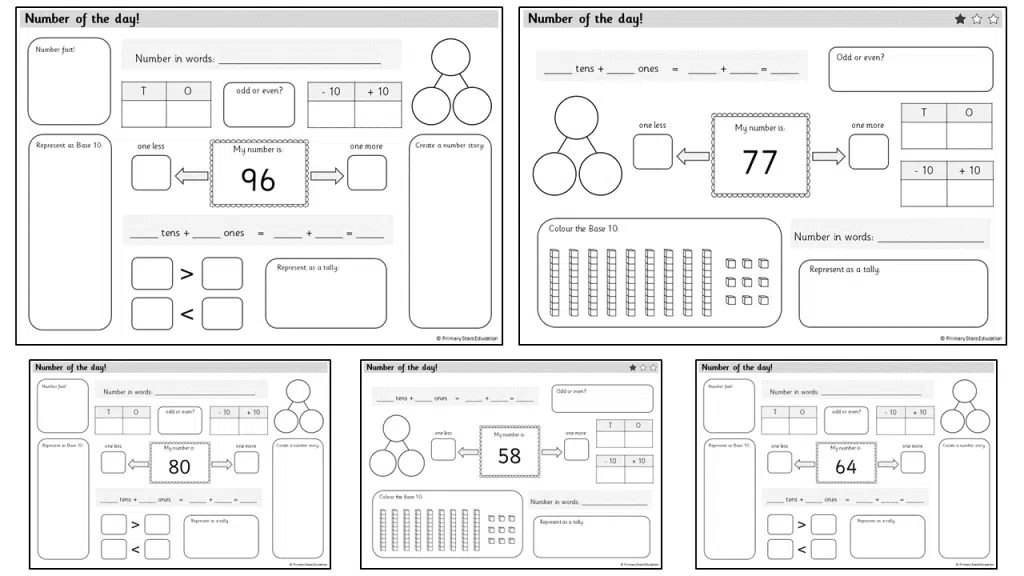
Number of the day (within 100) | Activity

Number of the day (within 50) | Activity

Number of the day (within 20) | Activity

Subtraction grids (within 100) | Activity

Addition grids (within 100) | Activity

Subtraction grids (within 20) | Activity
Let us know..., login failed, ks1 upgrade....
If you wish to upgrade your subscription to Key Stage 1 please contact [email protected] or head over to our support page .
Please upgrade to a premium account to download this resource.
Please Log In
Please log in or sign up to access this feature.
Please log in or sign up to save this resource.
Invoice Request
This resource is not included in your Year 2 subscription.
Upgrade below to gain access to all premium resources
This resource is not included in your Year 1 subscription.
Upgrade below to gain access to all premium resources!
- International
- Education Jobs
- Schools directory
- Resources Education Jobs Schools directory News Search

Addition and Subtraction : Number Bonds to 100 and Word Problems FREE Worksheets
Subject: Mathematics
Age range: 7-11
Resource type: Worksheet/Activity
Last updated
2 July 2020
- Share through email
- Share through twitter
- Share through linkedin
- Share through facebook
- Share through pinterest

This resource contains two worksheets on number bonds to 100 and word problems involving addition and subtraction up to and within 100 taken from a workbook designed to support the delivery of the Year 2 Number: Addition and Subtraction Block 2 - Autumn Term White Rose (WRM) ‘small steps’ programme. Click on the link for more details.
Year 2 Number: Addition and Subtraction Block 2 - Autumn Term Workbook 2
This is a 20 page workbook (with answers and progress check) of mastery maths resources to support the delivery of the Year 2 Number: Addition and Subtraction Block 2 - Autumn Term White Rose (WRM) ‘small steps’ programme. These resources are for Week 2.
The workbook contains 20 worksheets / activities (concrete, pictorial and abstract) linked to the White Rose small steps with an emphasis on the mastery approach to learning advocated by the White Rose scheme and includes reasoning and problem-solving tasks. The workbooks are available in both PDF and word format to enable editing and personalisation of the workbook.
The resources focus on the following objectives and small steps:
Year 2 Maths’ National Curriculum Objectives
Recall and use addition and subtraction facts to 20 fluently Derive and use related facts up to 100 Add and subtract numbers using concrete objects, pictorial representations, and mentally, including: a two-digit number and ones; a two-digit number and tens; two two-digit numbers; adding three one-digit numbers Show that the addition of two numbers can be done in any order (commutative) and subtraction of one number from another cannot. Solve problems with addition and subtraction: using concrete objects and pictorial representations, including those involving numbers, quantities and measures; applying their increasing knowledge of mental and written methods. Recognise and use the inverse relationship between addition and subtraction and use this to check calculations and solve missing number problems.
White Rose Small Steps
Bonds to 100 (tens) Add and subtract 1s 10 more and 10 less Add and subtract 10s
More Free Maths Resources
Thinking of publishing your own resources? Check out this step-by-step guide:
How to Become a Successful TES Author: Step-by-Step Guide
Creative Commons "NoDerivatives"
Your rating is required to reflect your happiness.
It's good to leave some feedback.
Something went wrong, please try again later.
Super! Thank you for sharing.
Many thanks for your review.
Empty reply does not make any sense for the end user
Nyctalusnoctula
Thank you for taking the time to leave a rating. It is greatly appreciated.
Thank you for taking the time to rate this resource. It is greatly appreciated.
Thank you for sharing!
Thank you for taking the time to leave a rating. It is much appreciated!
Report this resource to let us know if it violates our terms and conditions. Our customer service team will review your report and will be in touch.
Not quite what you were looking for? Search by keyword to find the right resource:

IMAGES
VIDEO
COMMENTS
Use these fun, illustrated activity cards to teach your KS1 class their number bonds up to 10. These differentiated cards come in three versions depending on ability, with pictures to help your students solve the problem in front of them. This fun game can be played in pairs or small groups and are an excellent way to help your students ...
This guide shares everything you need to know about number bonds to 10 and includes a free number bonds worksheet and answer key. ... However, if we rewrite this problem as: 10 - X = 7 where x=3. We can see how understanding number bonds can apply to more advanced problems including high school level algebra.
Number bonds to 10 | Mastery Cards. Year: 1. Pages: 1. Answers: Yes. Problem solving and reasoning cards allowing children to solve complex problems in various contexts for number bonds to 10. Photos.
Problem solving and reasoning cards: To make 10 on the ten frame you need to draw 8 more counters. I need 4 more cubes to make a number bond to 10. Always. Sometimes. ... Number bonds to 10 contain two different numbers added together. Always, sometimes or never? Explain how you know. Kat has 10p to spend. 3p. 4p. 9p. 8p. 7p.
Number bonds let students split numbers in useful ways. They show how numbers join together, and how they break down into component parts. When used in Year 1, number bonds forge the number sense needed for early primary students to move to addition and subtraction. As students progress, number bonds become an essential mental problem-solving ...
Use these year 1 maths mastery cards to help children master number bonds of 10. Children use practical equipment and a variety of representations, including ten-frames, number lines and part-whole models. They apply their knowledge of number bonds to reasoning and problem-solving activities. This resource links to the year 1 maths national curriculum aim 'Represent and use numbers bonds and ...
This set of mastery worksheets are filled with fluency reasoning and problem-solving activities aimed specifically at KS2 children who have not quite grasped the number bonds of 10. This worksheet contains visual models and images, a variety of calculations and some open-ended word problems. It is the perfect resource to help lower-attaining children embed their conceptual understanding of ...
A number bond consists of a minimum of three circles connected by lines. The "whole" is written in the first circle and its "parts" are written in the adjoining circles. The "parts" when added together will then equal the "whole". The following number bond can be used to represent four number sentences. 3 + 2 = 5. 2 + 3 = 5.
This set of mastery worksheets are filled with fluency reasoning and problem-solving activities aimed specifically at KS2 children who have not quite grasped the number bonds of 10. This worksheet contains visual models and images, a variety of calculations and some open-ended word problems. It is the perfect resource to help lower-attaining children embed their conceptual understanding of ...
Bonds to 10 reasoning and problem solving worksheet. Answer sheet. National Curriculum Objectives: Mathematics Year 1: (1C1) Represent and use number bonds and related subtraction facts within 20. Mathematics Year 2: (2C1) Recall and use addition and subtraction facts to 20 fluently, and derive and use related facts up to 100. This resource is ...
Why do this problem? This problem is useful for consolidating number bonds to 10 and the corresponding subtraction facts. The novel context is likely to appeal to learners and encourage them to persevere. Children who are fluent with number bonds to 10 will still be challenged as the approach is not obvious, but logical reasoning will help them become more efficient in their search for a solution.
Visual Representation: The visual nature of the worksheet allows students to visualize and conceptualize number bonds to 10, enhancing their mathematical reasoning and problem-solving skills. Personalized Learning: Students have the opportunity to work at their own pace, drawing on their existing knowledge and skills to complete each 10 frame ...
For example to a solve problem like, 8 + 5 children can partition the 5 into 2 and 3 and then use their knowledge of number bonds to 10. The number sentence 8 + 5 could then be solved like this: 8 + 5. = 8 + 2 + 3. = 10 + 3. = 13. Number bonds to 10 include: 0 + 10 = 10. 1 + 9 = 10.
The sixth lesson on number, addition and subtraction, aimed at Year 1 and 2 pupils, in a series produced by the NCETM during the school closures period in su...
Number bonds (10) problem solving. Subject: Mathematics. Age range: 5-7. Resource type: Worksheet/Activity. File previews. pdf, 337.4 KB. This resource is a set of 8 question cards for children to apply their number bonds to 10 knowledge. The questions related to real life problems. The problems focus on addition and subtraction but also touch ...
Here are some online games for number bonds. 1. Number Bonds To 10. The game is by tiny tap, whereby you can learn the concept of the number bond to 10 using a root and number line. Here you can add the number to create a sum of 10. How to play number bond. Start by clicking a tiny tap to begin the game.
This number bonds to 10 activity is a dynamic and engaging tool designed to help children master their bonds to 10, within a real-life context of a toy shop. An engaging KS1 problem solving activity, with the skills of addition and money all in one resource! How does this resource engage children. The resource engages children's learning by ...
Number bonds to 10: Reasoning and Problem Solving, Maths, Year 1, Number, Addition and Subtraction, Addition, Number bonds, Sign Up to Download
This Year 1 Number Bonds to 10 lesson covers the prior learning of creating bonds to 10 using practical equipment, before moving onto the main skill of working writing and recalling number bonds to 10. ... This powerpoint can be used to model the questions that the children will complete on the Varied Fluency and Reasoning & Problem Solving ...
pptx, 1.17 MB. docx, 12.39 KB. This resource provides a full week of teaching slides designed for Year 1, focusing on subtraction with 10 and related number bond facts. The lessons incorporate a range of representations to enhance understanding and engagement. Each lesson includes reasoning and problem-solving opportunities, fostering deep ...
Number Bonds 10 and 20 Word Problems. Subject: Mathematics. Age range: 5-7. Resource type: Worksheet/Activity. File previews. docx, 67.99 KB. docx, 100.62 KB. Number Bonds 10 and 20 Word Problems. Addition and subtraction word problems.
The IMO, held annually since 1959, challenges the world's most elite young mathematicians with the most difficult problems in algebra, combinatorics, geometry and number theory.
Object Moved This document may be found here
Number frame number bonds (within 20) | Mastery Cards. Year: 1. Pages: 1. Answers: Yes. Problem solving and reasoning cards allowing children to solve complex problems in various contexts for number frame number bonds. Photos.
This resource contains two worksheets on number bonds to 100 and word problems involving addition and subtraction up to and within 100 taken from a workbook designed. International; Resources; ... Rose small steps with an emphasis on the mastery approach to learning advocated by the White Rose scheme and includes reasoning and problem-solving ...